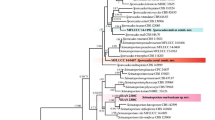Abstract
Ten species of Phomopsis have previously been identified from grapevines. Of these, P. viticola, the causal agent of Phomopsis cane and leaf spot, and P. vitimegaspora, the causal agent of swelling arm of grapevines, have been confirmed as severe pathogens of this host. Earlier taxonomic treatments of Phomopsis species chiefly distinguished taxa based on host specificity, cultural characteristics and morphology. More recent studies have indicated, however, that these characteristics can no longer be used to distinguish species of Phomopsis due to the wide host ranges of some species, and the morphological plasticity of others. Using morphology, DNA sequences (ITS-1, 5.8S, ITS-2) and pathogenicity data, 15 Phomopsis spp. were distinguished from grapevines in the present study. Diaporthe helianthi, a known pathogen of sunflowers, is for the first time reported from grapevines. A further six, presently unknown species of Phomopsis, are also distinguished from grapevines. A phylogenetic analysis of ITS data generated in this study distinguished three clades containing isolates previously identified as D. perjuncta. Based on type studies, the name D. viticola can be applied to collections from Portugal and Germany. A new species, D. australafricana, is proposed for South African and Australian isolates formerly treated as D. perjuncta or D. viticola. A description for D. perjuncta is provided based on newly designated lectotype and epitype specimens. D. perjuncta is distinguished from D. viticola and D. australafricana based on morphology and DNA phylogeny. Artificial inoculations of green grapevine shoots indicated that, of the species tested, P. amygdali, a known pathogen of peaches in the USA, and P. viticola were the most virulent.
Similar content being viewed by others
References
Farr DF, Castlebury LA, Pardo-Schultheiss RA (1999) Phomopsis amygdali causes peach shoot blight of cultivated peach trees in the southeastern United States. Mycologia 91, 1008–1015.
Hillis DM, Bull JJ (1993) An empirical test of bootstrapping as a method for assessing confidence in phylogenetic analysis. Systematic Biology 42, 182–192.
Kajitani Y, Kanematsu S (2000) Diaporthe kyushuensis sp. nov. the teleomorph of the causal fungus of grapevine swelling arm in Japan, and its anamorph Phomopsis vitimegaspora. Mycoscience 41, 111–114.
Kuo K, Leu L-S (1998) Phomopsis vitimegaspora: a pathogenic Phomopsis from vines. Mycotaxon 66, 497–499.
Lee SB, Taylor JW (1990) Isolation of DNA from fungal mycelia and single spores. In ‘PCR protocols: a guide to methods and applications’. (Eds MA Innis, DH Gelfand, JJ Sninsky, TJ White) pp. 282–287. (Academic Press: San Diego)
Melanson DL, Rawnsley B, Scheper RWA (2002) Molecular detection of Phomopsis taxa 1 and 2 in grapevine canes and buds. Australasian Plant Pathology 31, 67–73. doi: 10.1071/AP01075
Merrin SJ, Nair NG, Tarran J (1995) Variation in Phomopsis recorded on grapevine in Australia and its taxonomic and biological implications. Australasian Plant Pathology 24, 44–56.
Moleleki N, Preisig O, Wingfield MJ, Crous PW, Wingfield BD (2002) PCR-RFLP and sequence data delineate several Diaporthe species associated with stone and pome fruit trees in South Africa. European Journal of Plant Pathology 108, 909–912. doi: 10.1023/A:1021296801350
Mostert L, Crous PW, Kang J-C, Phillips AJL (2001) Species of Phomopsis and a Libertella sp. occurring on grapevines with specific reference to South Africa: morphological, cultural, molecular and pathological characterization. Mycologia 93, 146–167.
Muntañola-Cvetković M, Mihaljčević M, Petrov M (1981) On the identity of the causative agent of a serious Phomopsis-Diaporthe disease in sunflower plants. Nova Hedwigia 34, 417–435.
Niessl G von (1876) Hedwigia 15, 153.
Pearson RC, Goheen C (1994) Phomopsis cane and leaf spot. In ‘Compendium of grape diseases’. (Eds WB Hewitt, RC Pearson) pp. 17–18. (APS Press: St Paul, MI)
Phillips AJL (1999) The relationship between Diaporthe perjuncta and Phomopsis viticola on grapevines. Mycologia 91, 1001–1007.
Pine TS (1958) Etiology of the dead-arm. Phytopathology 48, 192–197.
Pine TS (1959) Development of the grape dead-arm disease. Phytopathology 49, 738–743.
Pscheidt JW, Pearson RC (1989) Effect of grapevine training systems and pruning practices on occurrence of Phomopsis cane and leaf spot. Plant Disease 73, 825–828.
Rambaut A (2002) ‘Sequence Alignment Editor. Version 2.0.’ (Department of Zoology, University of Oxford: Oxford)
Rawnsley B, Scott E, Wicks T, Stummer B (2001) Phomopsis type 1: a peculiar puzzle to solve. The Australian Grapegrower & Winemaker 452, 41–43.
Rawnsley B, Wicks T (2002) Fungicides for cane and leaf spot control. The Australian Grapegrower & Winemaker 465, 20.
Rayner RW (1970) ‘A mycological colour chart.’ (Commonwealth Mycological Institute: Kew)
Rehner SA, Uecker FA (1994) Nuclear ribosomal internal transcribed spacer phylogeny and host diversity in the coelomycete Phomopsis. Canadian Journal of Botany 72, 1666–1674.
Saccardo PA (1882) Omnium hucusque cognitorum. Sylloge Fungorum 1, 1–766.
SAS (1999) ‘SAS/STAT user’s guide. Version 8.2, volume 2.’ (SAS Institute Inc.: SAS Campus Drive, Cary, NC)
Scheper RWA, Crane DC, Whisson DL, Scott ES (2000) The Diaporthe teleomorph of Phomopsis Taxon 1 on grapevines. Mycological Research 104, 226–231. doi: 10.1017/S095375629900115X
Swofford DL (2000) ‘Phylogenetic analysis using parsimony. Version 4.0bl0.’ (Sinauer Associates: Sunderland, MA, USA)
Uddin W, Stevenson KL, Pardo-Schultheiss RA (1997) Pathogenicity of a species of Phomopsis causing shoot blight on peach in Georgia and evaluation of possible infection courts. Plant Disease 81, 983–989.
Uddin W, Stevenson KL, Pardo-Schultheiss RA, Rehner SA (1998) Pathogenicity and molecular characterization of three Phomopsis isolates from peach, plum, and Asian pear. Plant Disease 82, 732–737.
Uecker FA (1988) A world list of Phomopsis names with notes on nomenclature, morphology and biology. Mycologia Memoir 13, 1–231.
Wehmeyer LE (1933) ‘The genus Diaporthe Nitsche and its segregates.’ (University of Michigan Press: Ann Arbor)
White TJ, Bruns T, Lee S, Taylor J (1990) Amplification and direct sequencing of fungal ribosomal RNA genes for phylogenetics. In ‘PCR protocols: a guide to methods and applications’. (Eds MA Innis, DH Gelfand, JJ Sninsky, TJ White): pp. 315–322. (Academic Press: San Diego)
Author information
Authors and Affiliations
Corresponding author
Rights and permissions
About this article
Cite this article
van Niekerk, J.M., Groenewald, J.Z., Farr, D.F. et al. Reassessment of Phomopsis species on grapevines. Australasian Plant Pathology 34, 27–39 (2005). https://doi.org/10.1071/AP04072
Received:
Accepted:
Issue Date:
DOI: https://doi.org/10.1071/AP04072




